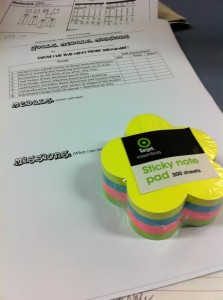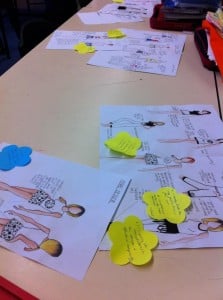Last Saturday, I went to the Project Learning Swap Meet organised by Bianca and Lee Hewes. It was inspiring, challenging and ultimately motivational in a ‘Make this happen’ sort of way. So then, while I thought my first blog post about PLSM would be about the day, I’m now blogging about how I came to making it real and happening on my first school-day back, in the middle of an existing project.
Circled are some of the ideas I thought I’d implement straight away.
I teach 8 Technology and on my rotation, students learn about Textiles and Digital Technology with a project involving the Design, Production and Evaluation of a pyjama set. It’s a common task for 4 classes taught by 3 teachers, including myself. The task has plenty of PBL elements including student voice and choice. Collaboration happens but more incidental than planned. Products are displayed along the hallway for all the school to see.
After attending PLSM, I felt inspired, challenged and motivated to implement some of what I learned on the day. Because I spent hours yesterday designing a Project Packet for year 7s (subject of another post), I decided to focus on something smaller for year 8s; something NEW that would be beneficial straight away.
Year 8s are submitting the Design products tomorrow which include sketches of their ideas and Final Design (the PJ set they’re actually going to make). I thought it would be good for them to get peer feedback prior to submission.
Techniques used (got all these from PLSM):
- Gallery Walk – items for feedback are put on display and peers write feedback on post-it notes
- Scaffolded Feedback – Based on @missjessm ‘s suggestion of “I like…Have you considered…”, the class decided to use +1 for “I like” and a star for the “Have you considered…”. Students suggested the ‘star’ and I’m still unsure why, maybe because it’s easy to draw?
- Goals, Medals, Missions (I’ve used this before but the document here is new to me) – using the task assessment criteria, I listed the Goals. These were the basis of the +1 and star comments as well….i.e. things to consider when writing feedback
Students each had 3 post-it notes so they had to be more picky of what they wrote and who they wrote for. They could always add a +1 or star if they agreed on what has already been posted. It worked really well and every design got peer feedback. This went on for about 10-15 minutes.
Everyone then got their sketches and considered the peer feedback and filled in their Goals, Medals, Missions sheets.
Here’s what I observed:
- Quality of peer feedback was excellent and the use of scaffold was evidently effective (eeek, that sounds so teacher-y)
- Students appreciated the +1s and even more so, the stars – i.e. suggestions for improvements
- Students were surprised at how true the peer comments were, making the +1 even more affirming
- Students were more motivated and directed to create better quality products
- Some students noticed things I haven’t (how good is this??? and yes, I’m collecting the post-it notes and GMMs)
- I’ll know my students more based on their GMMs
It was soooooo worth getting this happening straight away. Read more about the above techniques and MORE in Bianca’s super post about managing the mushy middle.


